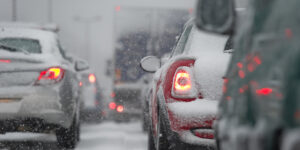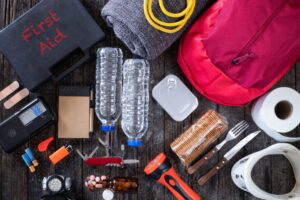Under extreme weather conditions, drivers must take extra measures to stay safe on the road. This may involve slowing down, increasing their following distance, and turning on their headlights.
Poor weather can create hazardous roads by rendering tires slippery, decreasing tire grip, and leading to skidding on icy roads. Furthermore, poor visibility limits visibility making it harder for drivers or road signs to see one another.
1. Slow Down
From driving through a fierce blizzard to foggy conditions, slowing down and increasing following distance are essential safety practices to follow when encountering adverse weather. Avoid puddles which could hide potholes or other hazards that cause skidding that could force your car off course and veer into other lanes of traffic.
Keep a greater distance between yourself and the vehicle in front of you to allow enough time for unexpected stops or slowdowns from the driver in front of you, as well as reduce the risks of rear-end collisions.
2. Increase Your Following Distance
Weather can make it more difficult to respond swiftly and responsibly when encountering obstacles in the roadway, thus increasing your following distance allows more space between yourself and the vehicle ahead.
Chain-reaction accidents often result from drivers following too closely, compounded by poor weather conditions that impair visibility. To establish a safe gap, select an object such as an overhead sign or tree along the road and count backward when the car in front passes it – when your count reaches “one thousand four,” that will indicate your optimal following distance.
3. Turn On Your Headlights
An important element of driving safely in adverse weather conditions is ensuring you can see, which means turning on your headlights when dark or foggy conditions exist. Furthermore, you must remain aware of your surroundings to prevent distractions and keep an eye out for potential dangers such as potholes.
Many states make it illegal to drive without your headlights on during the period between sunset and sunrise, when visibility drops below 1000 feet, or when visibility falls below 600 feet. Check that your headlights, windshield wipers, and tires are working properly; additionally, always buckle up! Fatigue can impair judgment and response time so it’s essential that drivers get enough rest prior to a long trip.
4. Leave Plenty of Room Between You and the Vehicle in Front of You
Adverse weather conditions present drivers with unique driving hazards. From slippery roads to limited visibility, adverse conditions can pose numerous driving challenges that put lives and bodies in peril. But drivers can prepare to navigate challenging weather conditions safely by decreasing speed, increasing following distance, and taking extra care when steering, turning, braking, or turning.
As a best practice, it is advised that drivers leave twice their usual distance between themselves and the car in front of them. This buffer zone gives drivers time to respond quickly in unexpected situations and reduces risks of rear-end collisions. Furthermore, this distance protects vehicles from sudden flooding of puddles that might puddle suddenly.
5. Stay in the Middle Road
Driving in bad weather requires increased vigilance and special precautions. Rain, snow, fog, and ice present significant hazards on the roads when drivers venture out on them.
Safe driving techniques should be practiced under controlled circumstances to help drivers understand how to react in various loss of control situations such as hydroplaning, skidding, and hydroplane stalls – leading to safer driving both for themselves and for others who share the road with them.
Increased following distance, leaving plenty of space between your vehicle and the one in front of it, and employing your hazard lights when necessary can help mitigate accidents caused by low visibility or slippery roads. Furthermore, to further ensure your safety avoid driving over puddles of water which could cause your car to hydroplane.
6. Avoid Puddles
Driving in poor weather conditions is far more dangerous than you may realize, but certain driving tips for rain can help ensure a safer journey on the roads.
Do your best to travel at or below the speed limit when driving in wet conditions and steer clear of puddles if possible – they could contain potholes, downed power lines, or other dangers that could compromise the integrity of your vehicle. If driving through one is necessary, take an easy, gradual approach to reduce hydroplaning risks; if conditions become unsafe then find a safe spot where you can pull over temporarily until the rain stops falling.
7. Stay on the Right Side of the Road
Driving on the right side of the road during inclement weather conditions is the safest choice, making it easier to spot hazards like standing water and ice while also reducing collision risk with other vehicles.
Staying in the middle of the road is also highly advised, as puddles can hide potholes or other hazards on either side. Furthermore, driving on either side may cause your vehicle to hydroplane and lose control.
Make sure that when turning, your turn signals remain illuminated for extended periods. Accelerating slowly is also advised in snow and icy conditions in order to prevent spinning your tires and potentially spinning off their axles.
8. Stay Alert
Due to the increased risk of accidents due to poor weather, it’s especially essential for drivers in adverse conditions to remain vigilant and stay focused while driving. Logity Dispatch advises staying abreast of weather forecasts and traffic reports to adjust your schedule accordingly.
One of the primary causes of car accidents is distracted driving. One glance away could cause you to miss an unslippery patch or rear-end another vehicle on the road, potentially leading to catastrophic results.
If you find yourself distracted while driving, find a safe spot to stop and rest until your mood has improved.
9. Avoid Distractions
Drivers need to remain extra cautious when driving in adverse weather conditions. Even the briefest lapse can have disastrous results; to reduce distractions and ensure drivers can concentrate, devices such as smartphones should be powered down before starting up the car.
Reducing manual distractions such as taking your hands off the wheel to adjust a radio or reach for beverages should wait until your destination.
If a tornado warning sounds, it’s wise to seek shelter instead of driving during severe weather conditions. However, following these safety tips could help ensure your arrival at your destination safely.




